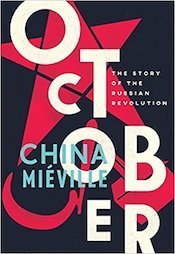China Miéville is best known for his fiction. His novels weave intricate worlds of fantastic architecture, complex politics and intimate personal relationships into tales that combine intrigue and the mundane; the lofty and the subterranean; and fear and its opposite. The results of these efforts serve as metaphor for the current reality and as fictions sometimes too amazing to be believed. His latest work shares all of these phenomena that make Miéville’s fiction so unique. However, the tale he tells in this work, titled October: The Story of the Russian Revolution is not fiction, but historical fact. This in itself makes it profoundly more breathtaking, and equally fantastic. It is a story of the year 1917 in revolutionary Russia.
As any student of Twentieth Century history knows, the year of the Russian revolution was one of those years that changed the course of human history. World War One—an imperialist quarrel that ended up being an incomprehensible exercise in human slaughter and a precursor to another even deadlier conflict—was in its final throes. Troops were dying, mutinying, and just walking away from the horror that was their  war. Civilians young and old struggled to survive; some became angels of mercy while others turned into barely human monsters. In between these two extremes were the bulk of European and Russian humanity. The nobility, generals and the bourgeoisie in all nations involved in the conflict were angling on how to keep their positions, their lands and their wealth. Revolutionaries watched, waited and organized; they knew their moment was nigh.
war. Civilians young and old struggled to survive; some became angels of mercy while others turned into barely human monsters. In between these two extremes were the bulk of European and Russian humanity. The nobility, generals and the bourgeoisie in all nations involved in the conflict were angling on how to keep their positions, their lands and their wealth. Revolutionaries watched, waited and organized; they knew their moment was nigh.
Given its momentous place in human history, there are numerous histories of the Russian Revolution told from a multitude of viewpoints. The three-volume set written by the Russian revolutionary Leon Trotsky is probably the most complete and certainly the most inspiring of all of these histories. It goes almost without saying that the revolution itself has been disparaged by capitalists and their cheerleaders ever since that first moment in February 1917 when the soviets took over in Petrograd. Even more damaging then the aspersions of the capitalist media though, was the counterrevolution launched against the revolutionary government and the subsequent machinations of that government which caused its mutation and ultimate dissolution barely eighty years later.
As I noted above, China Miéville just published a new history of the Russian Revolution’s first year—1917. It is a fast-paced history that weaves in and out of the debates and discussions in the soviets, the various revolutionary and leftist political parties, the military and the provisional government. At the same time, the readers is presented with vignettes of actions in the streets, at the battle front, in the apartments where Lenin is hiding and conspiring with other Bolsheviks for the revolutionary overthrow of a provisional government leaning further and further to the right. As Miéville’s story unfolds, the momentousness of the history being told reveals itself in a manner similar to a new wave film. The movements of individual revolutionaries, aristocrats, fearful but boisterous generals, wavering liberals, and angry worker and peasant masses play across the screen of the reader’s mind with a passion and clarity that defies rhetoric as surely as the revolution defied the arrogant assumptions of the Tsar and his sycophants.
There are many who have claimed the legacy of the revolutions of 1917. There will be many more who will attempt to do so in the future. The reality though, is that that legacy is not a thing of the past, but is part of an ongoing struggle to define and change the human condition. The fact of its existence as history serves as both a lesson and an inspiration. Miéville’s book serves both functions. Perhaps more importantly, it also serves as an introduction to the Russian revolution for those who might otherwise ignore it. This latter group probably includes many fans of Miéville’s fiction; readers unaware of his socialist leanings and possibly apolitical in the extreme. October is short on analysis, which is not a critique of the text. Indeed, this is a work of historic journalism. It’s as if John Reed, author of the classic piece of revolutionary journalism, Ten Days That Shook the World, woke from a decades-long sleep to tell the story of 1917 once again. Although there is less personal detail, the sweep of Miéville’s story is equal to Reed’s in its breadth while matching it in passion. It is Reed’s contention that the masses of workers, peasants and soldiers were at the front of the revolution. One hundred years later, Miéville’s telling agrees.